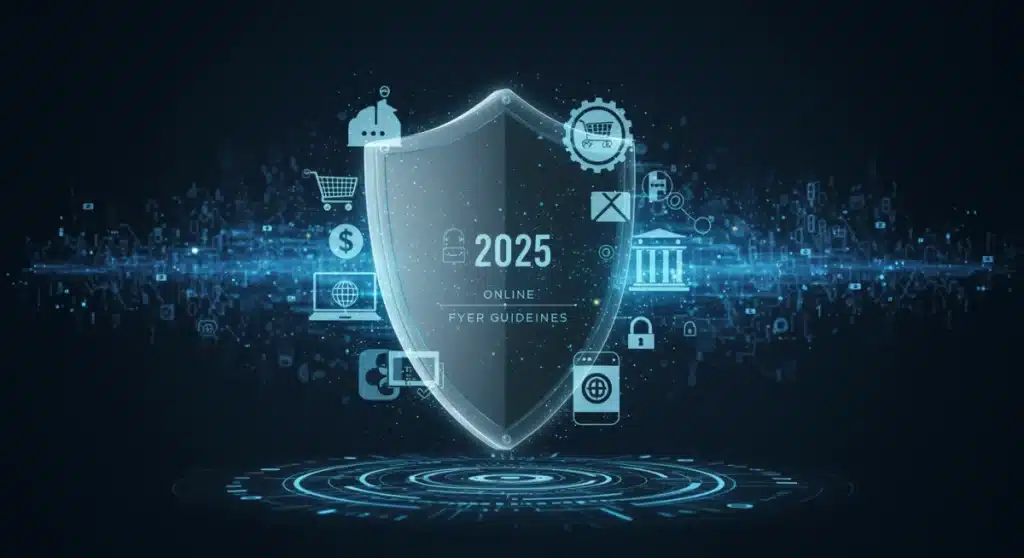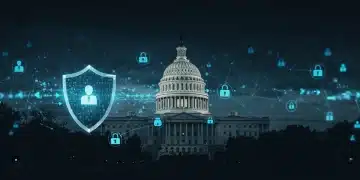FTC 2025 Guidelines: Protecting Consumers from Digital Scams

The 2025 FTC Guidelines are set to significantly enhance consumer protection against emerging digital scams, introducing stricter regulations and enforcement mechanisms to safeguard individuals in the evolving online landscape.
As the digital world rapidly evolves, so do the threats to consumers. The Federal Trade Commission (FTC) is poised to implement new guidelines in 2025, a critical step in Decoding the 2025 FTC Guidelines: Protecting Consumers from Emerging Digital Scams. These forthcoming regulations aim to fortify defenses against the increasingly sophisticated tactics employed by cybercriminals, ensuring a safer online environment for everyone.
Understanding the Genesis of the 2025 FTC Guidelines
The landscape of digital commerce and communication has transformed dramatically in recent years. This rapid evolution has unfortunately created fertile ground for new and more complex digital scams. As such, the FTC has been actively monitoring these trends, culminating in the development of the 2025 guidelines.
These guidelines are not an overnight creation but rather the result of extensive research, public consultations, and collaboration with industry experts. The FTC’s goal is to create a robust framework that is both adaptable to future technological changes and immediately effective against current threats. The need for updated regulations has become increasingly apparent with the rise of AI-powered scams, deepfakes, and more convincing phishing attempts that target unsuspecting individuals and businesses alike.
The Driving Force Behind New Regulations
Several factors have underscored the urgency for these new guidelines. Consumer complaints regarding online fraud have surged, indicating a clear gap in existing protections. The sheer volume and sophistication of scams, ranging from identity theft to cryptocurrency fraud, necessitated a comprehensive and forward-thinking response.
- Escalating Digital Threats: The proliferation of advanced digital technologies has empowered scammers with new tools.
- Increased Consumer Vulnerability: More daily activities moving online expose individuals to greater risks.
- Outdated Legal Frameworks: Existing regulations often lag behind technological advancements, requiring modernization.
The FTC’s proactive stance aims to close these loopholes and establish a new baseline for digital consumer protection.
Key Provisions of the Upcoming 2025 FTC Guidelines
As of recent announcements, the 2025 FTC Guidelines introduce several pivotal provisions designed to empower consumers and hold malicious actors accountable. These measures span various aspects of digital interaction, from data privacy to advertising practices, reflecting a holistic approach to online safety.
One of the central tenets is the emphasis on proactive measures rather than reactive responses. Businesses will face increased scrutiny regarding their data handling practices and their responsibility in preventing the dissemination of fraudulent content. The guidelines push for greater transparency and clearer communication with consumers about potential risks.
Enhanced Data Privacy and Security
The new guidelines are expected to significantly strengthen data privacy regulations. Companies handling consumer data will be required to implement more rigorous security protocols and provide clearer disclosures regarding data collection and usage.
- Mandatory Data Breach Notifications: Stricter timelines and requirements for informing affected individuals about data breaches.
- Data Minimization Principles: Encouraging companies to collect only essential data, reducing potential exposure.
- Improved Consent Mechanisms: Ensuring consumers provide explicit, informed consent for data sharing.
These provisions aim to reduce the risk of personal information falling into the wrong hands, a common precursor to many digital scams.
Combating Deceptive Practices in Digital Advertising
Digital advertising is a primary vector for many emerging scams, from fraudulent product claims to misleading investment opportunities. The 2025 FTC Guidelines are specifically targeting these deceptive practices, aiming to restore trust in online commercial interactions.
The FTC recognizes that scammers often leverage sophisticated advertising techniques, including targeted ads and influencer marketing, to reach and deceive a wide audience. The new rules will place a greater burden on advertisers and platforms to ensure the veracity of claims and the legitimacy of promotions. This includes a focus on ‘dark patterns’ — design choices that trick users into making unintended decisions.
New Standards for Online Transparency
Transparency will be a cornerstone of the new regulations concerning digital advertising. This means clearer identification of sponsored content, disclosure of affiliate relationships, and a crackdown on fake reviews or testimonials.
- Clear Disclosure of Endorsements: Influencers and marketers must conspicuously disclose paid partnerships.
- Prohibition of Misleading ‘Dark Patterns’: Design elements intended to manipulate consumer choices will be illegal.
- Accountability for Ad Platforms: Platforms hosting ads may face greater responsibility for the content they publish.
These changes are designed to empower consumers with accurate information, allowing them to make informed decisions without undue influence or deception.

Protecting Consumers from AI-Powered Scams and Deepfakes
The rapid advancement of artificial intelligence (AI) presents both opportunities and significant challenges, particularly in the realm of digital scams. AI-powered deepfakes and sophisticated chatbots are making it increasingly difficult for consumers to discern genuine interactions from fraudulent ones. The 2025 FTC Guidelines directly address these emerging threats.
These guidelines recognize that traditional warning signs for scams are becoming less effective as AI allows for more convincing impersonations and personalized deceptive content. The focus is on developing methods to identify and mitigate AI-generated fraudulent content, as well as holding platforms accountable for the tools they provide that could be misused.
Strategies Against Synthetic Media Fraud
Combating deepfakes and AI-generated scams requires a multi-faceted approach, emphasizing both detection and preventative measures. The FTC’s guidelines are expected to mandate certain safeguards.
- Detection Technologies: Encouraging the development and deployment of tools to identify AI-generated content.
- Attribution and Provenance: Requirements for disclosing when content is AI-generated or synthetic.
- Rapid Response Mechanisms: Protocols for quickly taking down fraudulent AI-generated content.
These measures aim to reduce the effectiveness of AI as a tool for deception, protecting individuals from highly convincing but ultimately false information.
Enforcement and Penalties Under the New Guidelines
The effectiveness of any regulatory framework hinges on its enforcement. The 2025 FTC Guidelines are expected to feature strengthened enforcement mechanisms and potentially higher penalties for non-compliance, reflecting the FTC’s commitment to consumer protection.
The FTC intends to send a clear message that violations of these new rules will carry significant consequences. This includes not only monetary fines but also potential legal action against individuals and organizations found to be engaging in or facilitating digital scams. The goal is to create a strong deterrent effect, making it less profitable and riskier for malicious actors to operate.
Increased Accountability for Platforms and Businesses
A significant shift under the new guidelines is the increased accountability placed on digital platforms and businesses. They will be expected to play a more active role in policing their services for fraudulent activity.
- Higher Fines for Non-Compliance: Monetary penalties for violations are expected to increase substantially.
- Broader Scope of Enforcement: The FTC may expand its reach to address a wider range of digital entities.
- Consumer Redress Mechanisms: Easier pathways for consumers to seek compensation for damages incurred by scams.
This emphasis on accountability aims to foster a shared responsibility across the digital ecosystem in safeguarding consumers.
Preparing for the 2025 FTC Guidelines: A Call to Action
With the 2025 FTC Guidelines on the horizon, businesses and consumers alike need to begin preparing for the changes. This proactive approach will ensure compliance for companies and enhanced protection for individuals navigating the digital landscape.
For businesses, understanding the nuances of the new regulations is paramount. This involves reviewing current practices related to data handling, advertising, and content moderation to identify areas requiring adjustment. Investing in compliance training and technological upgrades will be crucial. For consumers, staying informed about the evolving nature of digital scams and understanding their rights under the new guidelines is key to personal safety.
Steps for Businesses and Consumers
Both sectors have distinct but equally important roles in adapting to the new regulatory environment. Early preparation can mitigate risks and maximize the benefits of improved online security.
- Businesses: Conduct compliance audits, update privacy policies, and invest in robust cybersecurity measures.
- Consumers: Educate themselves on new scam tactics, utilize multi-factor authentication, and report suspicious activities.
- Collaboration: Foster open communication between industry, regulators, and consumer advocacy groups.
The collective effort in embracing these guidelines will be instrumental in creating a more secure and trustworthy digital future for everyone.
| Key Provision | Brief Description |
|---|---|
| Enhanced Data Privacy | Stricter rules for data handling, breach notifications, and consumer consent. |
| Deceptive Ad Combat | New standards for transparency in digital advertising and fighting ‘dark patterns’. |
| AI & Deepfake Protection | Measures to detect and mitigate AI-generated fraudulent content and synthetic media. |
| Stronger Enforcement | Increased penalties and broader accountability for platforms and businesses. |
Frequently Asked Questions About the 2025 FTC Guidelines
The primary goals are to enhance consumer protection against emerging digital scams, strengthen data privacy, combat deceptive digital advertising, and address threats posed by AI-powered fraud and deepfakes, ensuring a safer online environment.
Businesses will face increased scrutiny over data handling, advertising transparency, and content moderation. They must implement robust security protocols, update privacy policies, and ensure compliance to avoid significant penalties.
The guidelines aim to mandate detection technologies, require disclosure of AI-generated content, and establish rapid response mechanisms for fraudulent synthetic media to protect consumers from advanced deceptive tactics.
Yes, the 2025 guidelines are expected to introduce easier pathways for consumers to seek compensation for damages incurred by digital scams, alongside increased accountability for platforms and businesses facilitating such fraud.
While specific implementation dates are still being finalized, the guidelines are slated to take effect in 2025. Businesses and consumers should monitor official FTC announcements for precise timelines and detailed compliance requirements.
What Happens Next
The impending implementation of the 2025 FTC Guidelines marks a pivotal moment in the ongoing battle against digital scams. As compliance deadlines approach, businesses must proactively adapt their operations to meet the new standards for data privacy, advertising ethics, and AI content. Consumers, meanwhile, are encouraged to stay vigilant and informed, leveraging the enhanced protections and reporting mechanisms. The FTC’s commitment signals a future where digital interactions are safer, more transparent, and less susceptible to the ever-evolving tactics of cybercriminals. We anticipate further guidance and enforcement actions as these critical regulations fully take hold.





